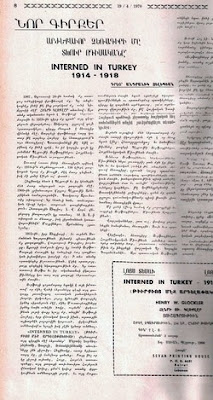Vaհe H. Apelian
Yesterday, September 30 was International Translation Day. The designation was adopted by UN General Assembly in 2017, for the role of language professionals play in connecting nations and fostering peace, understanding. The day was chosen because “30 September celebrates the feast of St. Jerome, the Bible translator, who is considered the patron saint of translators."
I was reminded of a blog I wrote about translating the book about Simon Simonian.
During the war and destruction in Aleppo, Levon Sharoyan wrote a very personal monograph about the eminent man of letters, Simon Simonian. He published it in installments first on his Facebook page, later on in a more expanded version in “Kantsasar” Weekly, the official newsletter of the Prelacy of the Armenian Apostolic Church in Aleppo. Levon’s monograph was his tribute to his elder compatriot. Levon’s grandfather, much like Simon Simonian’s father, hailed from Sassoun and was depicted among the stories Simon Simonian’s wrote about the struggles of the Sassountsi mountaineers on the plains of Aleppo.
The monograph, which since then has been published as a book in Armenia, made for a fascinating reading. I thought that it would be unfair for those who do not read Armenian to remain deprived of such a reading. Consequently, I asked Levon’s permission to have it translated to English. He readily gave it.
I then contacted Sassoun, Simon Simonian's son, who resides in Beirut, for the same purpose. It turned out that Sassoun had also thought of the same. Not only that, coincidentally, having read my published translation of one of Simon Simonian’s most endearing stories titled, “He Was Different”, he had me in mind for the task for a fee. Naturally, I categorically declined the monetary offer while appreciating his trust. Hence the draft of my translation of Levon Sharoyan’s monograph came about.
Upon Sassoun’s recommendation I sent a copy of my draft to Maria-Eleni Simonian, Simon Simonian’s granddaughter, who read the monograph and pointed out typos and offered suggestions. At the end of her review, she wrote the following to me: "It was a great pleasure to be able to read and learn more about my grandfather. It is one of my aspirations to learn Armenian and read his work to get a small picture of who he was. I believe you brought justice to your endeavor. Thank you for your time and contribution." Her note validated the undertaking of this task.
I also sent a copy to my final draft to my maternal cousin Jack Chelebian M.D. who lives on Padre Island, Texas. Jack graciously and ably edited the draft manuscript by painstakingly comparing my translation, line by line, to the original text. Jack spent no less time than I did in finalizing the translation. I can certainly attest that this translated piece is true to the original thanks greatly to Jack’s efforts as well.
Sassoun also read the draft translation and offered valuable suggestions in presenting the titles of Simon Simonian’s books as well as the personal names. He undertook the expense of publishing the book in Amzazon through The Simon Simonian Family Foundation.
Transliteration is an inherent part of translations. There arises a challenging situation because Eastern Armenians and Western Armenians do not necessarily transliterate similarly. Whenever possible I resorted to the Internet search engines to check on the common English transliteration of names and their sounding in Western Armenian.
I hope that interested readers find the translated piece as enjoyable to read as I did reading the original work. The book is retailed on Amazon.
Last but not the least, the following individuals are acknowledged in the book for their labors of love.
Translating: Vahe H. Apelian, Ph.D. (Loveland, OH)
Editing: Jack Chelebian, M.D. (Padre Island, TX)
Reviewing: Maria-Ellen Simonian (Huddersfield, England)
Proof reading: Sassoun Simonian (Antelias, Lebanon)
Publishing: Hrach Kalsahakian (Dubai, UAE)












